Pollution and Health Risk Assessment of Potentially Toxic Elements in Groundwater in the Kǒnqi River Basin (NW China)
Abstract
:1. Introduction
2. Materials and Methods
2.1. Study Area
2.2. Groundwater Sampling
2.3. Chemical Analysis
2.4. Quality Assurance and Quality Control (QA/QC)
2.5. Pollution Level of PTEs in Groundwater
2.6. Probabilistic Health Risk Assessment
2.7. Monte Carlo Simulation (MCS)
2.8. Statistical Analysis
3. Results
3.1. The Contents of PTEs in Groundwater
3.2. The Spatial Distribution of PTEs in Groundwater
3.3. Pollution Levels of PTEs in Groundwater
3.4. The Non-Carcinogenic Health Risks of PTEs in Groundwater
3.5. The Carcinogenic Health Risks of PTEs in Groundwater
3.6. Sensitivity Analysis
4. Discussion
5. Conclusions
Author Contributions
Funding
Institutional Review Board Statement
Informed Consent Statement
Data Availability Statement
Conflicts of Interest
References
- Somalya, D.; Komal, S.; Navdeep, S. Water quality and health risk assessment of heavy metals in groundwater of Ranbir Singh Pura tehsil of Jammu and Kashmir, India. Environ. Monit. Assess. 2023, 195, 1026–1044. [Google Scholar] [CrossRef]
- Muyassar, M.; Mamattursun, E.; Wang, L.L.; Xayida, S.; Wang, N.; Hu, Y.L. Pollution and ecological risk assessment of metal elements in groundwater in the Ibinur Lake Basin of NW China. Water 2023, 15, 4071. [Google Scholar] [CrossRef]
- Sheng, D.; Meng, X.; Wen, X.; Wu, J.; Yu, H.; Wu, M. Contamination characteristics, source identification, and source-specific health risks of heavy metal(loid)s in groundwater of an arid oasis region in Northwest China. Sci. Total Environ. 2022, 841, 156733. [Google Scholar] [CrossRef] [PubMed]
- Zanotti, C.; Rotiroti, M.; Fumagalli, L.; Stefania, G.A.; Canonaco, F.; Stefenelli, G.; Prévôt, A.S.H.; Leoni, B.; Bonomi, T. Groundwater and surface water quality characterization through positive matrix factorization combined with GIS approach. Water Res. 2019, 159, 122–134. [Google Scholar] [CrossRef] [PubMed]
- Gao, J.B.; Li, Z.Q.; Chen, Z.J.; Zhou, Y.; Liu, W.G.; Wang, L.; Zhou, J.B. Deterioration of groundwater quality along an increasing intensive land use pattern in a small catchment. Agri. Water Manag. 2021, 253, 106953. [Google Scholar] [CrossRef]
- Wang, L.; Tao, Y.; Su, B.; Wang, L.; Liu, P. Environmental and health risks posed by heavy metal contamination of groundwater in the Sunan coal mine, China. Toxics 2022, 10, 390. [Google Scholar] [CrossRef] [PubMed]
- Han, W.J.; Pan, Y.J.; Emily, W.; Liu, X.R.; Li, J.R.; Xu, S.D.; Peng, H.X.; Wang, F.T.; Li, X.; Shi, H.H.; et al. Prioritization of control factors for heavy metals in groundwater based on a source-oriented health risk assessment model. Ecotoxic. Environ. Safe 2023, 267, 115642. [Google Scholar] [CrossRef] [PubMed]
- Soleimani, H.; Azhdarpoor, A.; Hashemi, H.; Nasri, O.; Ghoochani, M.; Azizi, M.; Ebrahimzadeh, G.; Mahvi, A.H. Probabilistic and deterministic approaches to estimation of non-carcinogenic human health risk due to heavy metals in groundwater resources of Torbat Heydariyeh, southeastern of Iran. Inter. J. Environ. Anal. Chem. 2022, 102, 95–109. [Google Scholar] [CrossRef]
- Xiang, Z.J.; Wu, S.J.; Zhu, L.Z.; Yang, K.; Lin, D.H. Pollution characteristics and source apportionment of heavy metal(loid)s in soil and groundwater of a retired industrial park. J. Environ. Sci. 2024, 143, 23–34. [Google Scholar] [CrossRef]
- Adeyemi, A.A.; Ojekunle, Z.O. Concentrations and health risk assessment of industrial heavy metals pollution in groundwater in Ogun state, Nigeria. Sci. Afr. 2021, 11, 666. [Google Scholar] [CrossRef]
- Chen, L.W.; Yang, Y.T.; Ding, M.J.; Zhang, H.; Zou, F.; Wang, P.; Nie, M.H.; Huang, G.X.; Yan, C.X. Scale effects of multi-medium heavy metals in response to landscape indices in the Yuan River, China. J. Clean. Product. 2022, 373, 133784. [Google Scholar] [CrossRef]
- Singh, R.; Chakma, S.; Birke, V. Performance of field-scale permeable reactive barriers: An overview on potentials and possible implications for in-situ groundwater remediation applications. Sci. Total Environ. 2023, 858, 158838. [Google Scholar] [CrossRef] [PubMed]
- Yuan, L.Z.; Wang, K.; Zhao, Q.L.; Yang, L.; Wang, G.Z.; Jiang, M.; Li, L.L. An overview of in situ remediation for groundwater co-contaminated with heavy metals and petroleum hydrocarbons. J. Environ. Manag. 2024, 349, 119342. [Google Scholar] [CrossRef] [PubMed]
- Zhai, Y.; Zheng, F.; Li, D.; Cao, X.; Teng, Y. Distribution, genesis, and human health risks of groundwater heavy metals impacted by the typical setting of Songnen plain of NE China. Int. J. Environ. Res. Public Health 2022, 19, 3571. [Google Scholar] [CrossRef]
- Ahmad, B.; Hamed, S.; Samaneh, S.; Iman, P.; Amin, M.; Omid, A.; Parviz, J.; Hossein, F.; Kamal, B.N. Comprehensive health risk analysis of heavy metal pollution using water quality indices and Monte Carlo simulation in R software. Sci. Rep. 2023, 13, 15817. [Google Scholar] [CrossRef]
- Mirzabeygi, M.; Abbasnia, A.; Yunesian, M.; Nodehi, R.N.; Yousefi, N.; Hadi, M.; Mahvi, A.H. Heavy metal contamination and health risk assessment in drinking water of Sistan and Baluchistan, Southeastern Iran. Hum. Ecol. Risk. Assess. 2017, 23, 1893–1905. [Google Scholar] [CrossRef]
- Xiao, L.L.; Li, W.; Zhu, C.M.; Yang, S.J.; Zhou, M.; Wang, B.; Wang, X.; Wang, D.M.; Ma, J.X.; Zhou, Y.; et al. Cadmium exposure, fasting blood glucose changes, and type 2 diabetes mellitus: A longitudinal prospective study in China. Environ. Res. 2021, 192, 110259. [Google Scholar] [CrossRef] [PubMed]
- Riaz, R.M.Y.; Murtaza, G.; Farooqi, Z.U.R.; Ali, S.; Aziz, H.; Mahboob, S.; Al-Ghanim, K.A.; Owens, G.; Ahmad, H.R.; Riaz, U. Assessment of arsenic contamination in groundwater and associated human health risk. Sustainability 2022, 14, 12460. [Google Scholar] [CrossRef]
- Peana, M.; Pelucelli, A.; Chasapis, C.T.; Perlepes, S.P.; Bekiari, V.; Medici, S.; Zoroddu, M.A. Biological effects of human exposure to environmental cadmium. Biomolecules 2022, 13, 36. [Google Scholar] [CrossRef]
- Mamattursun, E.; Nazupar, S.; Zhong, Q.; Atiyagul, R.; Li, X.G. Distribution, pollution levels, and health risk assessment of heavy metals in groundwater in the main pepper production area of China. Open Geo. 2023, 15, 20220491. [Google Scholar] [CrossRef]
- Li, P.; Karunanidhi, D.; Subramani, T.; Srinivasamoorthy, K. Sources and consequences of groundwater contamination. Arch. Environ. Contam. Toxic. 2021, 80, 1–10. [Google Scholar] [CrossRef] [PubMed]
- Wang, Z.; Su, Q.; Wang, S.; Gao, Z.; Liu, J. Spatial distribution and health risk assessment of dissolved heavy metals in groundwater of eastern China coastal zone. Environ. Pollut. 2023, 290, 118016. [Google Scholar] [CrossRef]
- Brammer, H.; Ravenscroft, P. Arsenic in groundwater: A threat to sustainable agriculture in South and South-East Asia. Environ. Int. 2009, 35, 647–654. [Google Scholar] [CrossRef]
- Luiza, F.V.F.; Bruno, A.C.; Juliana, C.V.S.; Julio, C.J.S.; Nayara, H.M.; Fábio, K.; Valter, A.N.; Cassiana, C.M.; Kelly, M.P.O.; Alexeia, B. Metals and emerging contaminants in groundwater and human health risk assessment. Environ. Sci. Pollut. Res. 2019, 26, 24581–24594. [Google Scholar] [CrossRef]
- Qiao, J.; Zhu, Y.; Jia, X.; Shao, M.; Niu, X.; Liu, J. Distributions of arsenic and other heavy metals, and health risk assessments for groundwater in the Guanzhong Plain Region of China. Environ. Res. 2019, 181, 108957. [Google Scholar] [CrossRef] [PubMed]
- Hullysses, S.; Gerson, C.S.J.; Ricardo, C.; Juliana, M. Heavy metals and major anion content in groundwater of Tamoios coastal district (Rio de Janeiro/Brazil): Assessment of suitability for drinking purposes and human health risk. Inter. J. Environ. Anal. Chem. 2022, 102, 7357–7379. [Google Scholar] [CrossRef]
- Nemerow, N.L. Stream, Lake, Estuary, and Ocean Pollution; Van Nostrand Reinhold Publishing, Co.: New York, NY, USA, 1985. [Google Scholar]
- Velmurugan, V.; Murugan, K. Evaluation of heavy metals in ground and surface water in Ranipet, India utilizing HPI model. Environ. Monit. Assess. 2023, 195, 875. [Google Scholar] [CrossRef]
- Tyagi, S.; Sharma, B.; Singh, P.; Dobhal, R. Water quality assessment in terms of water quality index. Am. J. Water Res. 2020, 1, 34–38. [Google Scholar] [CrossRef]
- Chorol, L.; Gupta, S.K. Evaluation of groundwater heavy metal pollution index through analytical hierarchy process and its health risk assessment via Monte Carlo simulation. Process Safe. Environ. Pro. 2023, 170, 855–864. [Google Scholar] [CrossRef]
- Huang, J.L.; Wu, Y.Y.; Sun, J.X.; Li, X.; Geng, X.L.; Zhao, M.L.; Sun, T.; Fan, Z.Q. Health risk assessment of heavy metal(loid)s in park soils of the largest megacity in China by using Monte Carlo simulation coupled with Positive matrix factorization model. J. Hazard Mater. 2021, 415, 125629. [Google Scholar] [CrossRef]
- Mohammadpour, A.; Motamed-Jahromi, M.; Soleimani, H.; Dehbandi, R.; Doost, Z.E.; Samaei, M.R.; Derakhshan, Z.; Renella, G.; Mahvi, A.H. Trace elements human health risk assessment by Monte Carlo probabilistic method in drinking water of Shiraz, Iran. Inter. J. Environ. Sci. Technol. 2023, 20, 3775–3788. [Google Scholar] [CrossRef]
- Mohamed, H.E.; Mustafa, E.; Essam, A.M.; Hatem, S.R.; Madarász, T.; Attila, K.; Péter, S. New approach into human health risk assessment associated with heavy metals in surface water and groundwater using Monte Carlo Method. Sci. Rep. 2024, 14, 1008. [Google Scholar] [CrossRef]
- Sheng, D.; Wen, X.; Wu, J.; Wu, M.; Yu, H.; Zhang, C. Comprehensive probabilistic health risk assessment for exposure to arsenic and cadmium in groundwater. Environ. Manag. 2021, 67, 779–792. [Google Scholar] [CrossRef]
- Wen, X.H.; Li, L.M.; Wu, J.; Lu, J.; Sheng, D.R. Multiple assessments, source determination, and health risk apportionment of heavy metal(loid)s in the groundwater of the Shule River Basin in northwestern China. J. Arid Land 2023, 15, 1355–1375. [Google Scholar] [CrossRef]
- Zhang, J.; Yin, L.H.; Gu, X.F.; Li, Y.; Yang, B.C.; Jiang, J.; Jia, W.H.; Xie, W.B.; Wang, T.; Tang, X.P.; et al. Study on the relationship between groundwater and surface water in Xinjiang Kongque river basin using isotopes and hydrochemistry method. Northwestern Geo. 2021, 54, 185–195. (In Chinese) [Google Scholar] [CrossRef]
- Wang, L.C.; Yu, K.; Chang, L.; Zhang, J.; Tang, T.; Yin, L.H.; Gu, X.F.; Dong, J.Q.; Li, Y.; Jiang, J.; et al. Response of glacier area variation to climate change in the Kaidu-Kongque river basin, Southern Tianshan Mountains during the last 20 years. China Geo. 2021, 4, 389–401. (In Chinese) [Google Scholar] [CrossRef]
- Adila, H.; Mamattursun, E. Identification of the spatial distributions, pollution levels, sources, and health risk of heavy metals in surface dusts from the Korla city, NW China. Open Geosci. 2020, 12, 1338–1349. [Google Scholar] [CrossRef]
- HJ/T 164–2004; MEEPRC (Ministry of Ecology and Environment of the People’s Republic of China). Technical Specifications for Environmental Monitoring of Groundwater. Environmental Science Press of China: Beijing, China, 2004. (In Chinese)
- GB/T 14848–2017; AQSIQ (Administration of Quality Supervision, Inspection and Quarantine of China). Standard for Groundwater Quality. China Standard Press: Beijing, China, 2017.
- US EPA (U.S. Environmental Protection Agency). Regional Screening Levels (RSLs)-User’s Guide; US EPA: Washington, DC, USA, 2016.
- Peng, C.; Chen, W.; Liao, X.; Wang, M.; Ouyang, Z.; Jiao, W.; Bai, Y. Polycyclic aromatic hydrocarbons in urban soils of Beijing: Status, sources, distribution and potential risk. Environ. Pollut. 2011, 159, 802–808. [Google Scholar] [CrossRef] [PubMed]
- Sun, Y.; Zhou, J.; Yang, F.; Ji, Y.; Zeng, Y. Distribution and co-enrichment genesis of arsenic, fluorine and iodine in groundwater of the oasis belt in the southern margin of Tarim Basin. Earth Sci. Front. 2022, 29, 99–114. [Google Scholar] [CrossRef]
- Peng, C.; Cai, Y.; Wang, T.; Xiao, R.; Chen, W. Regional probabilistic risk assessment of heavy metals in different environmental media and land uses: An urbanization-affected drinking water supply area. Sci. Rep. 2016, 6, 37084. [Google Scholar] [CrossRef]
- Saha, N.; Rahman, M.S.; Ahmed, M.B.; Zhou, J.L.; Ngo, H.H.; Guo, W. Industrial metal pollution in water and probabilistic assessment of human health risk. J. Environ. Manag. 2017, 185, 70–78. [Google Scholar] [CrossRef] [PubMed]
- Rahman, M.M.; Bodrud-Doza, M.; Siddiqua, M.T.; Zahid, A.; Towfiqul Islam, A.R.M. Spatio-temporal distribution of fluoride in drinking water and associated probabilistic human health risk appraisal in the coastal region, Bangladesh. Sci. Total Environ. 2020, 724, 138316. [Google Scholar] [CrossRef] [PubMed]
- Liu, J.; Tuo, J.; Dai, S.; Rong, X.; Xing, X. Monitoring and analysis of arsenic content and valence state in rural drinking water from 2018 to 2020 in Aksu District. Chin. Endem. Dis. Cont. 2021, 36, 367–368. [Google Scholar]
- Giri, S.; Singh, A.K.; Mahato, M.K. Monte Carlo simulation-based probabilistic health risk assessment of metals in groundwater via ingestion pathway in the mining areas of Singhbhum copper belt, India. Inter. J. Environ. Health Res. 2019, 30, 447–460. [Google Scholar] [CrossRef] [PubMed]
- US EPA (U.S. Environmental Protection Agency). Exposure Factors Handbook, 2011th ed; US EPA: Washington, DC, USA, 2011.
- US EPA (U.S. Environmental Protection Agency). Risk Assessment Guidance for Superfund; Human Health Evaluation Manual; Part E (Volume 1); Supplemental Guidance for Dermal Risk Assessment; EPA/540/R/99/005, OSWER 9285.7-02EP, PB 99-963312; Office of Superfund Remediation and Technology Innovation: Washington, DC, USA, 2004.
- Jiang, C.; Zhao, Q.; Zheng, L.; Chen, X.; Li, C.; Ren, M. Distribution, source, and health risk assessment based on the Monte Carlo method of heavy metals in shallow groundwater in an area affected by mining activities, China. Ecotox. Environ. Safe 2021, 224, 112679. [Google Scholar] [CrossRef] [PubMed]
- US EPA (U.S. Environmental Protection Agency). Risk Assessment Guidance for Superfund: Volume III; Part A: Process for conducting probabilistic risk assessment; EPA 540-R-02-002; United States Environmental Protection Agency: Washington, DC, USA, 2001.
- US EPA (U.S. Environmental Protection Agency). Risk Assessment Guidance for Superfund; Human health evaluation manual, Part A (Volume 1); [EPA/540/1-89/002]; Office of Emergency and Remedial Response: Washington, DC, USA, 1989.
- Wen, X.H.; Lu, J.; Wu, J.; Lin, Y.C.; Luo, Y.M. Influence of coastal groundwater salinization on the distribution and risks of heavy metals. Sci. Total Environ. 2019, 652, 267–277. [Google Scholar] [CrossRef] [PubMed]
- Senoro, D.B.; de Jesus, K.L.M.; Nolos, R.C.; Lamac, M.R.L.; Deseo, K.M.; Tabelin, C.B. In situ measurements of domestic water quality and health risks by elevated concentration of heavy metals and metalloids using Monte Carlo and MLGI methods. Toxics 2022, 10, 342. [Google Scholar] [CrossRef] [PubMed]
- Xie, H.; Liang, Y.P.; Li, J.; Zou, S.Z.; Shen, H.Y.; Zhao, C.H.; Wang, Z.H. Distribution characteristics and health risk assessment of metal elements in groundwater of Longzici spring area. Environ. Sci. 2021, 42, 4257–4266. (In Chinese) [Google Scholar] [CrossRef]
- Shi, H.; Zeng, M.; Peng, H.; Huang, C.; Sun, H.; Hou, Q.; Pi, P. Health risk assessment of heavy metals in groundwater of Hainan Island using the Monte Carlo simulation coupled with the APCS/MLR model. Int. J. Environ. Res. Public Health 2022, 19, 7827. [Google Scholar] [CrossRef]
- Sun, J.; Huang, X.; Song, X.; Tang, R.; Zhao, M.; Cai, B.; Wang, H.; Han, Z.; Liu, Y.; Fan, Z. New insights into health risk assessment on soil trace metal (loid) s: Model improvement and parameter optimization. J. Hazard Mater. 2023, 458, 131919. [Google Scholar] [CrossRef]
- Yuan, B.; Cao, H.; Du, P.; Ren, J.; Chen, J.; Zhang, H.; Zhang, Y.; Luo, H. Source-oriented probabilistic health risk assessment of soil potentially toxic elements in a typical mining city. J. Hazard Mater. 2023, 443, 130222. [Google Scholar] [CrossRef] [PubMed]
- Cogliano, V.J.; Baan, R.; Straif, K.; Grosse, Y.; Lauby-Secretan, B.; El Ghissassi, F.; Bouvard, V.; Benbrahim-Tallaa, L.; Guha, N.; Freeman, C.; et al. Preventable exposures associated with human cancers. J. Natl. Cancer Inst. 2011, 103, 1827–1839. [Google Scholar] [CrossRef] [PubMed]
- Han, Y.P.; Gao, T.T.; Li, X.Z.; Wang, Y. Didactical approaches and insights into environmental processes and cardiovascular hazards of arsenic contaminants. Chemosphere 2024, 352, 141381. [Google Scholar] [CrossRef] [PubMed]
- Song, B.; Li, Q.Q.; Cao, Q. A mini-review regarding the control techniques available for arsenic contamination from flue gas and water. J. Environ. Chem. Eng. 2024, 12, 112249. [Google Scholar] [CrossRef]
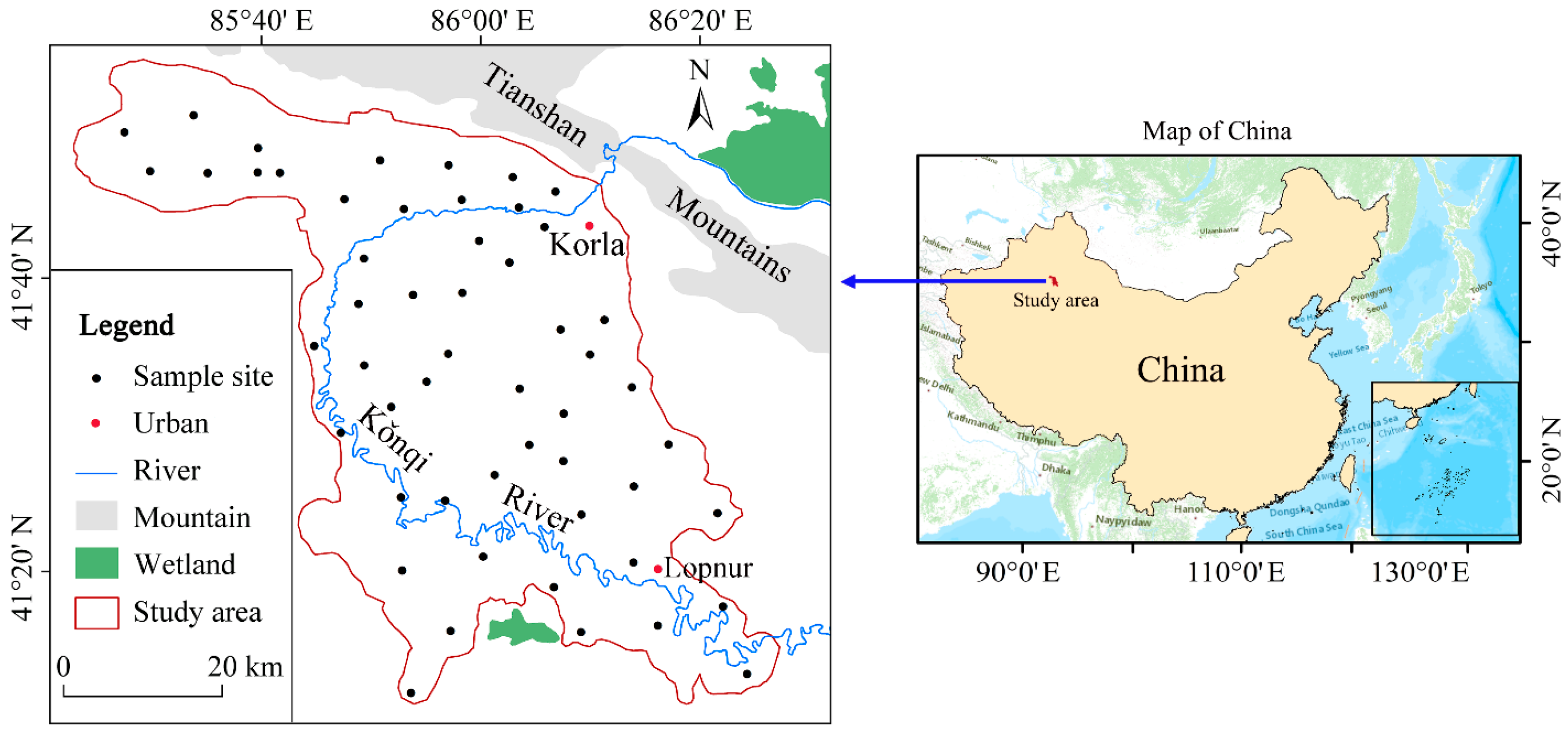

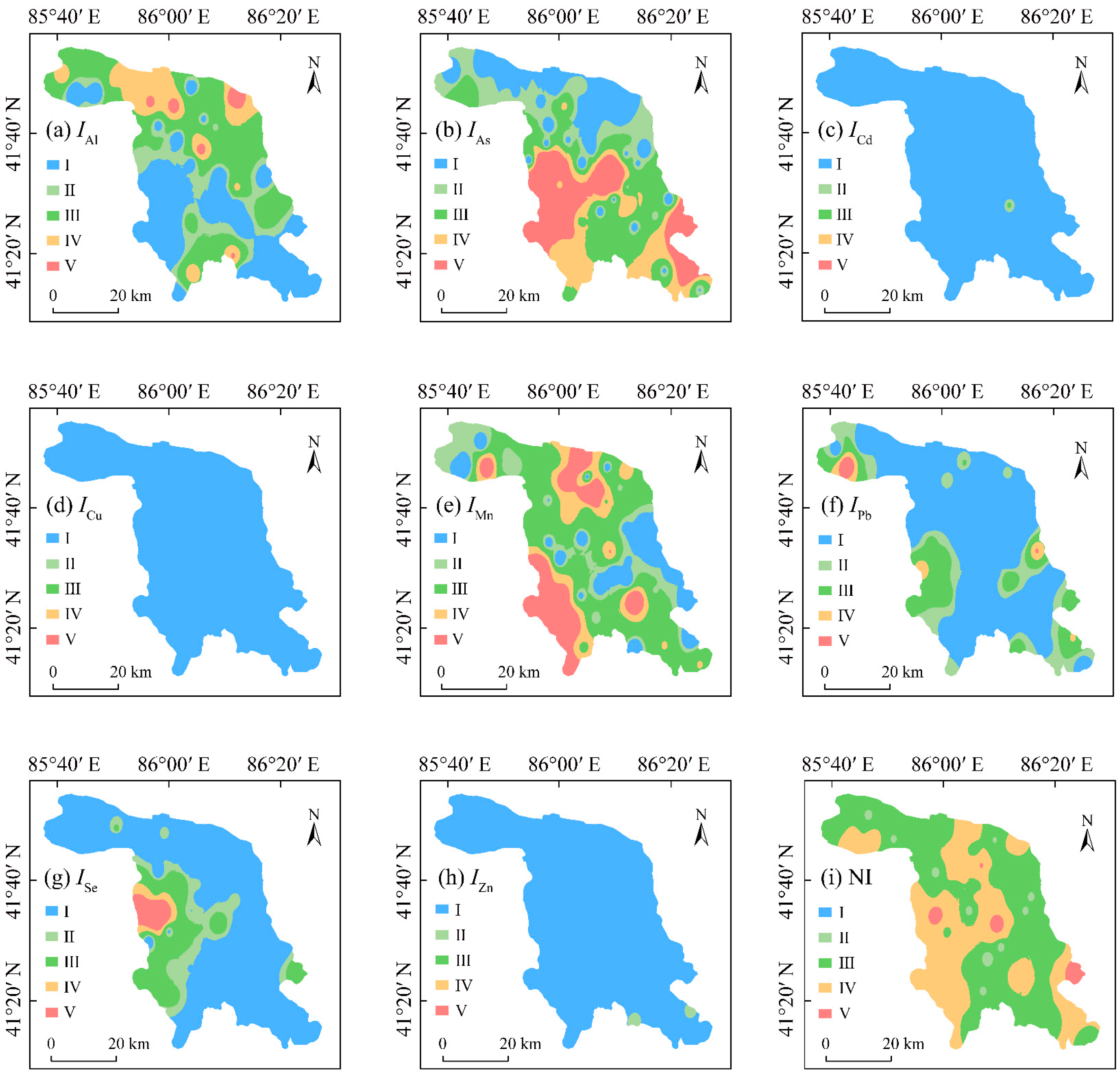
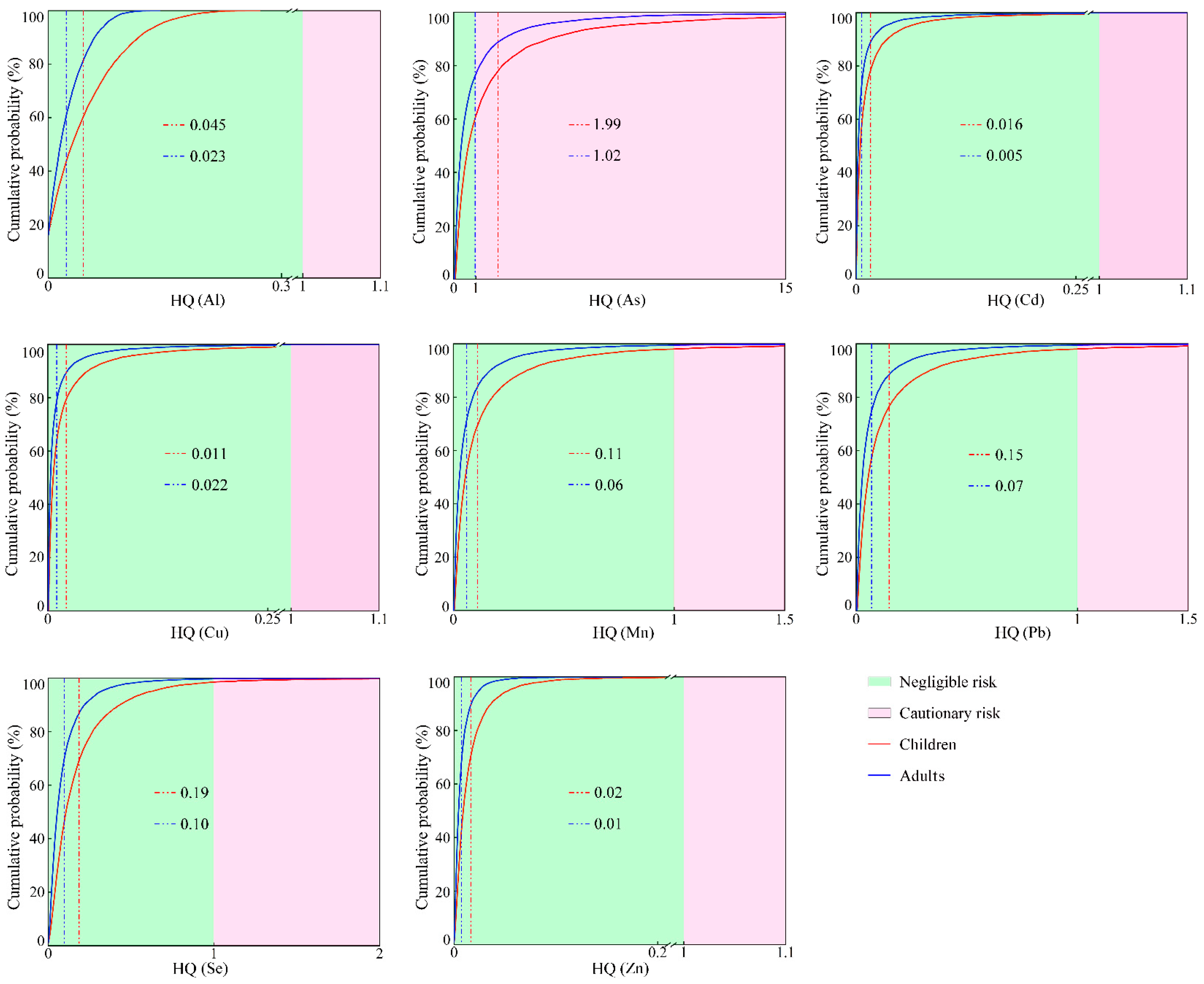
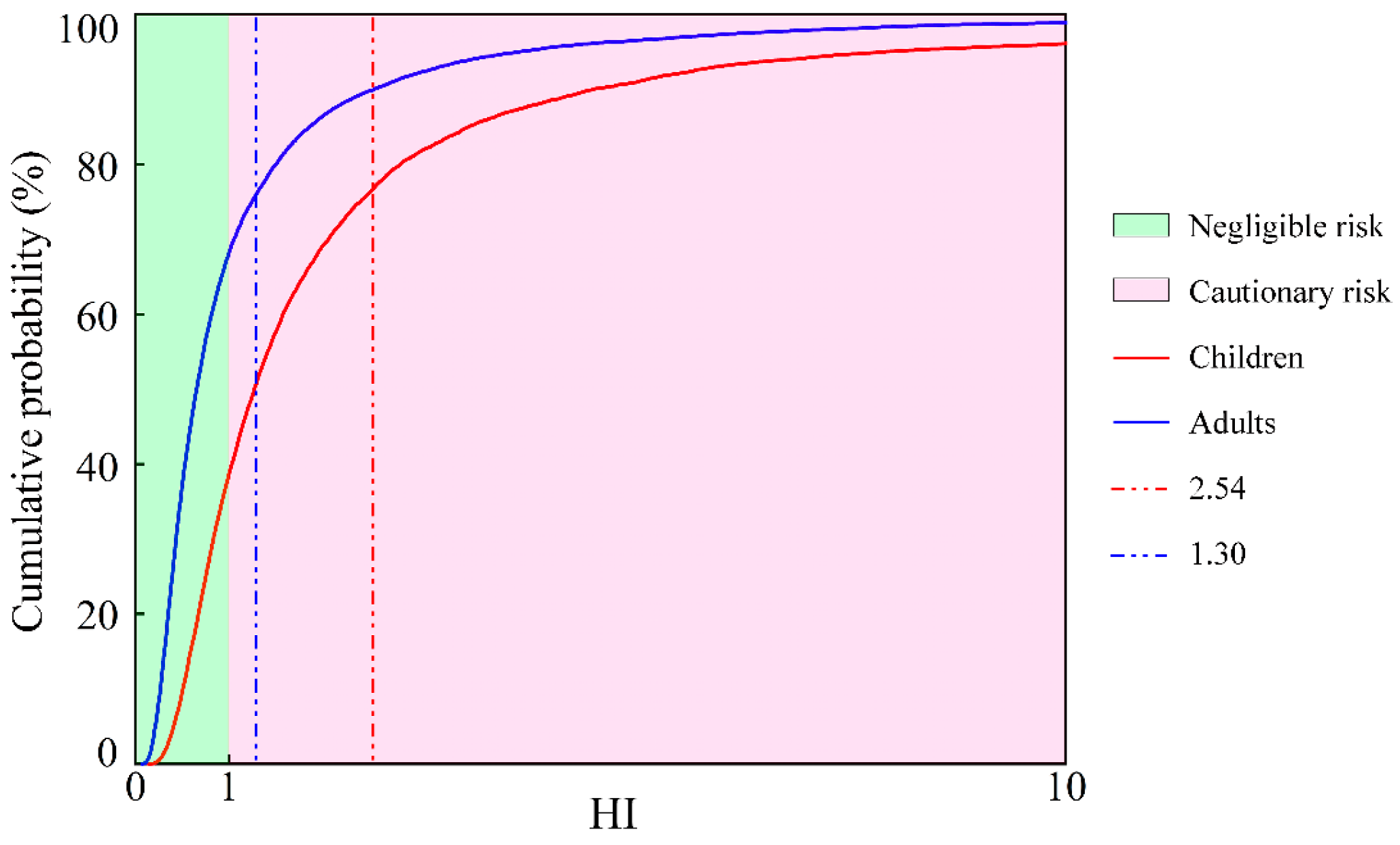

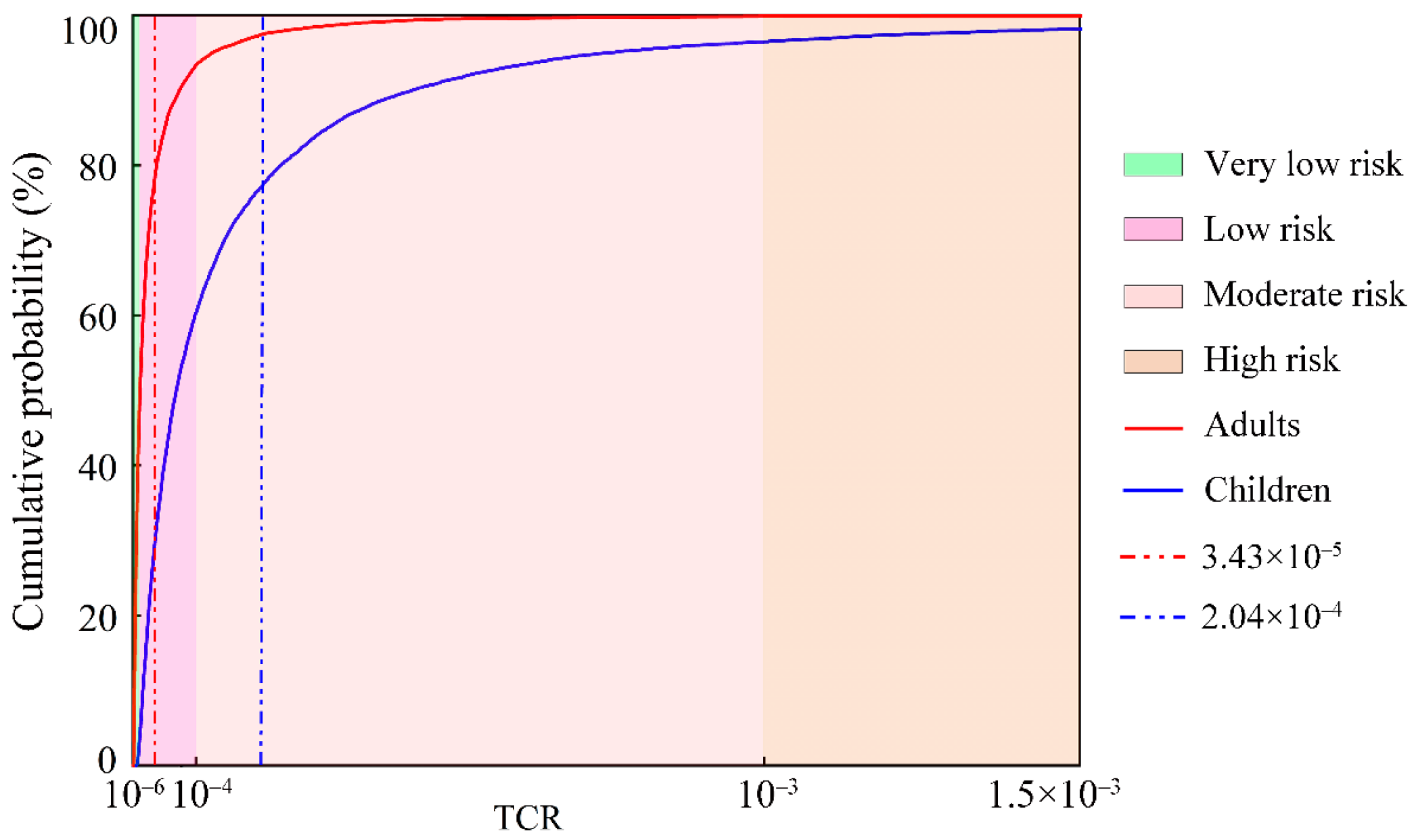
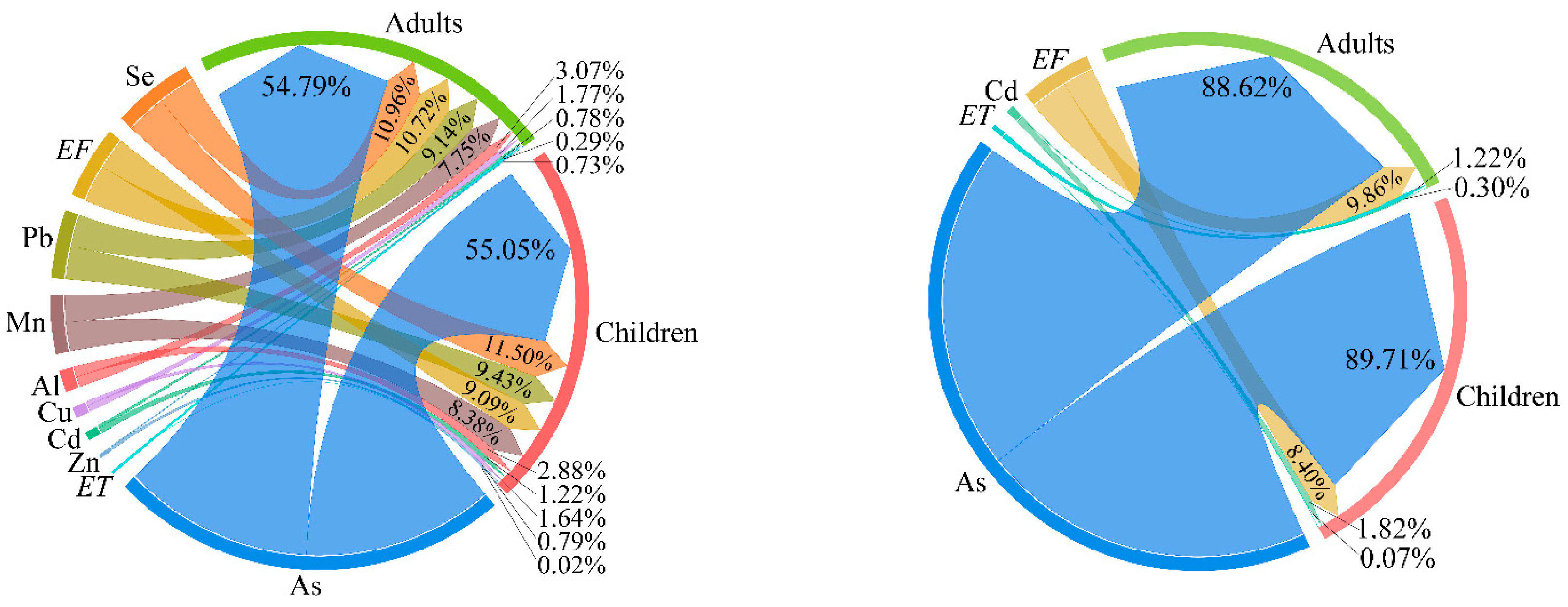
| Class | Pollution Degree | Ii | NI |
|---|---|---|---|
| I | No pollution | Ii < 0.7 | NI < 0.7 |
| II | Slightly pollution | 0.7 < Ii ≤ 1 | 0.7 < NI ≤ 1 |
| III | Low pollution | 1 < Ii ≤ 2 | 1 < NI ≤ 2 |
| IV | Moderate pollution | 2 < Ii ≤ 3 | 2 < NI ≤ 3 |
| V | High pollution | Ii > 3 | NI > 3 |
| Parameters | Al | As | Cd | Cu | Mn | Pb | Se | Zn |
|---|---|---|---|---|---|---|---|---|
| RfDoral | 0.14 | 0.003 | 0.0005 | 0.04 | 0.046 | 0.0014 | 0.001 | 0.3 |
| RfDdermal | 0.14 | 0.000285 | 0.000025 | 0.012 | 0.0018 | 0.00042 | 0.0015 | 0.06 |
| SForal | / | 1.5 | 6.1 | / | / | / | / | / |
| Items | Al | As | Cd | Cu | Mn | Pb | Se | Zn |
|---|---|---|---|---|---|---|---|---|
| Minimum/(μg/L) | 0.96 | 0.82 | 0.01 | 1.24 | 0.23 | 0.25 | 0 | 0.90 |
| Maximum/(μg/L) | 997.00 | 176.00 | 5.50 | 530.00 | 1047.00 | 45.90 | 97.30 | 944.00 |
| Mean/(μg/L) | 233.00 | 21.00 | 0.35 | 32.00 | 180.00 | 6.00 | 7.00 | 156.00 |
| Standard deviation/(μg/L) | 0.25 | 0.04 | 0.00088 | 0.08 | 0.23 | 0.01 | 0.01 | 0.19 |
| Coefficient of variation | 1.06 | 1.84 | 2.52 | 2.45 | 1.29 | 1.37 | 1.91 | 1.23 |
| Skewness | 1.09 | 3.13 | 4.49 | 5.33 | 2.06 | 2.52 | 5.32 | 2.61 |
| Kurtosis | 0.70 | 9.45 | 23.31 | 32.51 | 4.16 | 7.54 | 32.08 | 7.78 |
| * National standard/(mg/L) | 0.20 | 0.01 | 0.005 | 1.00 | 0.10 | 0.01 | 0.01 | 1.00 |
| Standard-exceeding ratio/(%) | 49.06 | 35.85 | 1.87 | 0 | 45.28 | 20.75 | 15.09 | 0 |
| Items | Ii | NI | |||||||
|---|---|---|---|---|---|---|---|---|---|
| Al | As | Cd | Cu | Mn | Pb | Se | Zn | ||
| Minimum | 0.005 | 0.082 | 0.002 | 0.001 | 0.002 | 0.025 | 0 | 0.001 | 0.280 |
| Maximum | 4.985 | 17.600 | 1.100 | 0.531 | 10.470 | 4.590 | 9.730 | 0.944 | 12.600 |
| Mean | 1.165 | 2.107 | 0.071 | 0.032 | 1.804 | 0.646 | 0.744 | 0.156 | 2.750 |
| CV | 1.056 | 1.844 | 2.787 | 2.449 | 1.289 | 1.372 | 1.911 | 1.228 | 0.988 |
Disclaimer/Publisher’s Note: The statements, opinions and data contained in all publications are solely those of the individual author(s) and contributor(s) and not of MDPI and/or the editor(s). MDPI and/or the editor(s) disclaim responsibility for any injury to people or property resulting from any ideas, methods, instructions or products referred to in the content. |
© 2024 by the authors. Licensee MDPI, Basel, Switzerland. This article is an open access article distributed under the terms and conditions of the Creative Commons Attribution (CC BY) license (https://creativecommons.org/licenses/by/4.0/).
Share and Cite
Hu, Y.; Eziz, M.; Wang, L.; Subi, X. Pollution and Health Risk Assessment of Potentially Toxic Elements in Groundwater in the Kǒnqi River Basin (NW China). Toxics 2024, 12, 474. https://doi.org/10.3390/toxics12070474
Hu Y, Eziz M, Wang L, Subi X. Pollution and Health Risk Assessment of Potentially Toxic Elements in Groundwater in the Kǒnqi River Basin (NW China). Toxics. 2024; 12(7):474. https://doi.org/10.3390/toxics12070474
Chicago/Turabian StyleHu, Yonglong, Mamattursun Eziz, Liling Wang, and Xayida Subi. 2024. "Pollution and Health Risk Assessment of Potentially Toxic Elements in Groundwater in the Kǒnqi River Basin (NW China)" Toxics 12, no. 7: 474. https://doi.org/10.3390/toxics12070474






